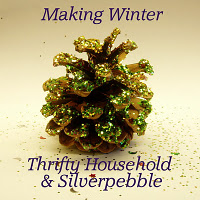Yesterday I went to two exhibitions that had been at the top of my
'must see' list . . . both were in London and I combined the trip with
delivering some unframed linocuts to Edwards & Todd in Museum
Street.
My next stop was just across the road and through the big gates of the British Museum . . .
. . . to see
Grayson Perry: The Tomb of the Unknown Craftsman, I'd been looking forward to seeing this for many months so I hoped it wasn't going to disappoint – it didn't!
The concept behind the exhibition is best
described by the artist himself and there are
some excellent photos here. I immediately warmed to the opening statement . . .
"Do not look too hard for meaning here.
I am not a historian,
I am an artist"
I'd been given permission to look and enjoy everything in the exhibition without the trappings of historical context or academic knowledge . . . they were here to tell a new story and one that involved the exhibition visitor on a pilgrimage to the tomb of the unknown craftsman – a representative maker who, like the unknown soldier in Westminster Abbey, represents all the men and women who skillfully created the thousands of artifacts in the collections of the British Museum.
Alongside the artifacts selected by Grayson Perry from the galleries and storerooms of the museum, there are his new artworks created to comment on themes: shrines, pilgrimage, relics, gender, craftsmanship, the patina of age . . .
The gallery was busy (but not over-crowded) with visitors, all intently looking at the exhibits which are beautifully displayed and simply labelled in classic museum style, whether they were ancient artifacts or new works made for the exhibition . . . another very enjoyable part of the experience was overhearing the comments . . .
"You look and ask which are ancient,
I can't guess which are which!"
The accompanying catalogue and the shop at the end is as much a part of the exhibition as the main exhibits, Grayson Perry had a hand in the content and design of both.
I won't try to describe the exhibits, but just highly recommend that you visit – it's engrossing, thought provoking and inspiring on many levels.
The second exhibition I was excited to see was here . . .
. . .
The Poster King at the
Estorick Collection in Islington – I hadn't heard of it either! The way I found out about this exhibition is a long story, I'll tell you a brief version, one day earlier this year, I received an email which wasn't meant for me but I recognised the name of the sender – it was a gentleman, with a very distinctive name, whom I'd interviewed for my final year art history project at art college! I decided to let him know his email had gone astray and after exchanging further emails, I admitted that I had regretted my choice of subject for the project and wished I'd continued my 2nd year studies about the work of Edward McKnight Kauffer. A month or so passed and I received another email from him, telling me that there was a major exhibition of McKnight Kauffer's work in London this autumn and he hoped I'd be able to go along to see it!
Edward McKnight Kauffer is today a known unknown of he art world – many of you will recognise his work, and many more will have been influenced by his ground breaking graphic design and typography, but few know his name.
You can read a short biography of Edward McKnight Kauffer and see some of his posters
on the Estorick Collection web site. The exhibition filled two galleries and comprised of original posters, gouache designs for posters, book illustrations and other graphic material, sketches and photographs – it was fascinating. EMKK was a pioneer in his field, among many innovations he was probably the first graphic designer to use photo-montage in his poster designs.
Edward McKnight Kauffer, BP Ethyl Controls Horse-power (1933) © BP Archive
He was influencial in the Fauvist, Surrealist and Constructivist art movements, a friend of writers and poets including Aldous Huxley, John Betjeman and TS Eliot, in England between the two World Wars, he was a celebrity.
I could go on . . . but I'll stop eulogising. I'll share with you a series of poster designs from the early 1920s entitled "Winter Sales are best reached by underground" – they were particularly apt on a wet and windswept day in streets of London devoid of traditional festive cheer.
In the inter-war years EMKK brought modern art to the streets and tunnels of London and a smile to commuters' faces.
The Poster King continues at the Estorick Collection for another week, closing on 18th December, it's well worth a visit if you're interested in graphic art and/or social history. If you're interested in 20th Century Italian art (or just love a good Italian café) it's well worth a visit any time.
I would very much like to find out more about how EMKK's gouche designs were translated into the large-scale posters by the printers . . . something I'm going to try to research, so if you can help or send me in the right direction, please let me know.
Celia
x












































